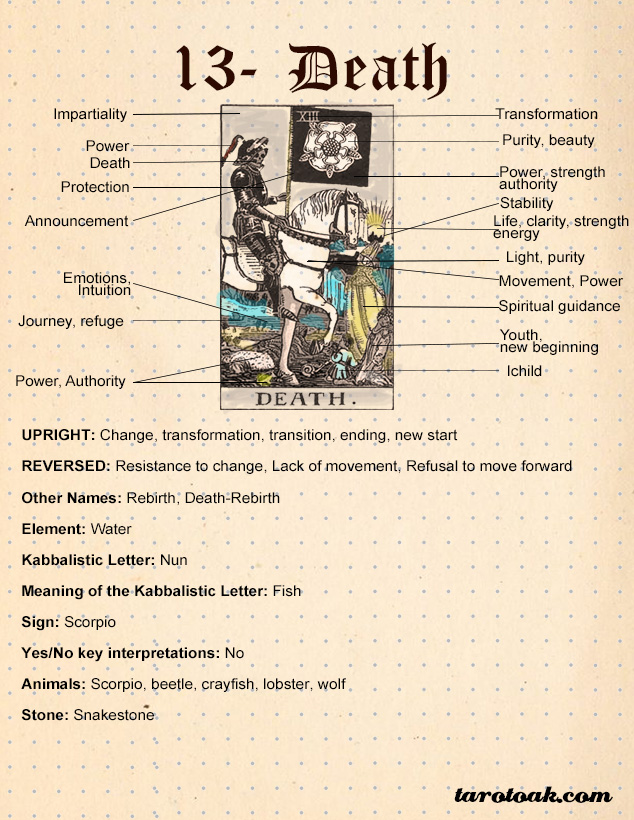The Death tarot card, often met with trepidation, evokes visceral emotions and prompts multifaceted interpretations. Contrary to its ominous nomenclature, the Death card serves as a profound harbinger of transformation, renewal, and the cyclical nature of existence. In this exploration, we shall delve into the symbolic fabric of the Death tarot card, unravel the nuanced meanings entwined within its imagery, and elucidate how its message resonates with both the apprehensive and the seasoned tarot reader.
Central to understanding the Death card is its rich symbolism, which often centers around a skeleton, the quintessential emblem of mortality. Draped in a dark cloak, the skeletal figure wields a scythe—an ancient instrument associated with harvest and reaping. Herein lies a metaphorical invitation: like a farmer harvesting crops, we too must prune our lives of that which no longer serves us. This imagery underscores the inevitability of change and the necessity to let go, a theme echoing throughout the human experience.
The backdrop of the Death card often portrays a setting sun, suggesting the conclusion of one chapter and the dawn of another. The presence of such contrasting elements speaks volumes; dusk, while signifying an end, also hints at the promise of a new day. This duality resonates deeply with the viewer, reminding us that every ending is inextricably intertwined with new beginnings.
In tarot readings, the Death card’s appearance invites introspection, urging individuals to consider what aspects of their lives might need relinquishing. It prompts a visceral examination of relationships, habits, and mindsets—inviting the question: what is ready to fall away? The essence of the Death card lies in its ability to instigate metamorphosis, akin to a caterpillar transforming into a butterfly. Without the shedding of the old, the beauty of what is yet to come cannot flourish.
Although often associated with physical demise, the Death card primarily symbolizes psychological and spiritual transformation. It beckons individuals to confront their inner landscapes: outdated beliefs, fears, and attachments. Embracing the card’s message can lead to catharsis, as releasing the burdens of the past paves the way for rebirth and rejuvenation. This renewal may not always unfold as a euphoric experience; often, it requires navigating through discomfort and uncertainty, akin to traversing a labyrinth before reaching an exit.
The Death card also emphasizes the significance of surrender. In a world that often promotes relentless striving and control, the Death card reminds us of the beauty in letting go. It encourages a state of flow, urging practitioners to yield to the currents of change rather than resist them. This surrender does not signify defeat; instead, it is a recognition of life’s impermanence and an embrace of the infinite possibilities that arise from the ashes of what has dissolved.
One hallmark of the Death card’s allure is its invitation to embrace life’s unpredictability. By confronting our mortality—symbolized through the card—we gain the ability to live more authentically. The acceptance of death, both literal and metaphorical, nurtures a profound appreciation for the present moment. Each experience, fleeting as it may be, becomes imbued with meaning. The paradox of the Death card lies in its ability to amplify the vibrancy of life through its focus on endings.
Additionally, the card often signifies transitions—not just personal, but also communal and societal shifts. In readings, it may herald a significant change in one’s career, relationships, or even broader societal dynamics. Such transitions may evoke anxiety, yet they also present opportunities for growth and evolution. The Death card, therefore, becomes a powerful ally, encouraging the embracing of transformation, both at an individual and collective level.
For those who might feel daunted by the card’s reputation, it’s crucial to remember the context within which it appears. Whether in a single-card draw or as part of a larger spread, the surrounding cards can provide additional clarity. When paired with cards that signify hope, renewal, or vitality, the Death card’s message may be one of harmonious change and positivity. Conversely, when surrounded by challenging cards, it may signal a period of intense inner upheaval or a need for prudent reflection before embarking on new ventures.
Moreover, the rhetoric surrounding the Death card has evolved in contemporary tarot practices, with many readers advocating for its interpretation as a symbol of empowerment rather than fear. This shift acknowledges the vital role of agency in navigating life’s transitions. Engaging with the Death card encourages individuals to take ownership of their narratives, transforming perceived threats into opportunities for personal sovereignty and growth.
In conclusion, while the Death tarot card initially elicits visceral reactions, its essence is one of profound transformation, renewal, and the beauty inherent in life’s cyclical nature. By embracing the card’s message of letting go and welcoming change, individuals can harness its transformative power as a catalyst for growth. Ultimately, the Death card serves as a potent reminder that in the realm of existence, endings are merely the precursors to new beginnings—a cycle that enriches the tapestry of life.









Leave a Comment